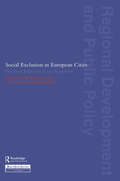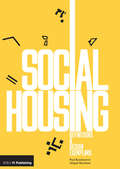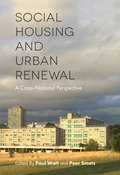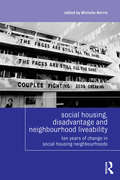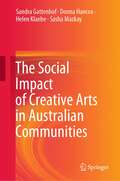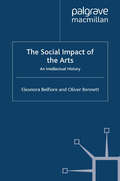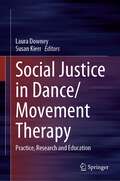- Table View
- List View
Social Exclusion in European Cities: Processes, Experiences and Responses (Regions and Cities)
by Judith Allen Goran Cars Ali MadanipourAcross Europe concern is rising over the disintegration of social relations and the growing number of people who are being socially excluded. social Exclustoin in European Cities, the first major study of this topic, provides a definition of social exclusion and looks at both the processes which cause it and the dimensions of the problem throughout Europe. The experiences of people living in areas or neighbourhoods with low rates of social integration are considered, illuminating the human impact of exclusion where it is most visible. Finally the contributors evaluate the various policy and community initiatives which are currently confronting the problem in a wide sample of European Cities on a variety of levels, from inform individual actions to supra-national European Union policy, and suggest new ways in which social exclusion could be tackled. With most large cities experiencing some degree of social exclusion, this is an important volume for all those working in the areas of regional policy, town planning, housing management, social work, community development, sociology, political science and urban studies.
Social Exclusion in European Cities: Processes, Experiences and Responses (Regions and Cities #No.23)
by Ali Madanipour Göran Cars Judith AlienAcross Europe concern is rising over the disintegration of social relations and the growing number of people who are being socially excluded. social Exclustoin in European Cities, the first major study of this topic, provides a definition of social exclusion and looks at both the processes which cause it and the dimensions of the problem throughout Europe. The experiences of people living in areas or neighbourhoods with low rates of social integration are considered, illuminating the human impact of exclusion where it is most visible. Finally the contributors evaluate the various policy and community initiatives which are currently confronting the problem in a wide sample of European Cities on a variety of levels, from inform individual actions to supra-national European Union policy, and suggest new ways in which social exclusion could be tackled. With most large cities experiencing some degree of social exclusion, this is an important volume for all those working in the areas of regional policy, town planning, housing management, social work, community development, sociology, political science and urban studies.
Social History of Art, Volume 1: From Prehistoric Times to the Middle Ages
by Arnold HauserFirst published in 1951 Arnold Hausers commanding work presents an account of the development and meaning of art from its origins in the Stone Age through to the Film Age. Exploring the interaction between art and society, Hauser effectively details social and historical movements and sketches the frameworks in which visual art is produced.This new edition provides an excellent introduction to the work of Arnold Hauser. In his general introduction to The Social History of Art, Jonathan Harris asseses the importance of the work for contemporary art history and visual culture. In addition, an introduction to each volume provides a synopsis of Hausers narrative and serves as a critical guide to the text, identifying major themes, trends and arguments.
Social History of Art, Volume 1: From Prehistoric Times to the Middle Ages
by Arnold HauserFirst published in 1951 Arnold Hausers commanding work presents an account of the development and meaning of art from its origins in the Stone Age through to the Film Age. Exploring the interaction between art and society, Hauser effectively details social and historical movements and sketches the frameworks in which visual art is produced.This new edition provides an excellent introduction to the work of Arnold Hauser. In his general introduction to The Social History of Art, Jonathan Harris asseses the importance of the work for contemporary art history and visual culture. In addition, an introduction to each volume provides a synopsis of Hausers narrative and serves as a critical guide to the text, identifying major themes, trends and arguments.
Social History of Art, Volume 2: Renaissance, Mannerism, Baroque
by Arnold HauserFirst published in 1951 Arnold Hauser's commanding work presents an account of the development and meaning of art from its origins in the Stone Age through to the Film Age. Exploring the interaction between art and society, Hauser effectively details social and historical movements and sketches the frameworks in which visual art is produced.This new edition provides an excellent introduction to the work of Arnold Hauser. In his general introduction to The Social History of Art, Jonathan Harris asseses the importance of the work for contemporary art history and visual culture. In addition, an introduction to each volume provides a synopsis of Hauser's narrative and serves as a critical guide to the text, identifying major themes, trends and arguments.
Social History of Art, Volume 2: Renaissance, Mannerism, Baroque
by Arnold HauserFirst published in 1951 Arnold Hauser's commanding work presents an account of the development and meaning of art from its origins in the Stone Age through to the Film Age. Exploring the interaction between art and society, Hauser effectively details social and historical movements and sketches the frameworks in which visual art is produced.This new edition provides an excellent introduction to the work of Arnold Hauser. In his general introduction to The Social History of Art, Jonathan Harris asseses the importance of the work for contemporary art history and visual culture. In addition, an introduction to each volume provides a synopsis of Hauser's narrative and serves as a critical guide to the text, identifying major themes, trends and arguments.
Social History of Art, Volume 3: Rococo, Classicism and Romanticism
by Arnold HauserFirst published in 1951 Arnold Hausers commanding work presents an account of the development and meaning of art from its origins in the Stone Age through to the Film Age. Exploring the interaction between art and society, Hauser effectively details social and historical movements and sketches the frameworks in which visual art is produced.This new edition provides an excellent introduction to the work of Arnold Hauser. In his general introduction to The Social History of Art, Jonathan Harris asseses the importance of the work for contemporary art history and visual culture. In addition, an introduction to each volume provides a synopsis of Hausers narrative and serves as a critical guide to the text, identifying major themes, trends and arguments.
Social History of Art, Volume 3: Rococo, Classicism and Romanticism
by Arnold HauserFirst published in 1951 Arnold Hausers commanding work presents an account of the development and meaning of art from its origins in the Stone Age through to the Film Age. Exploring the interaction between art and society, Hauser effectively details social and historical movements and sketches the frameworks in which visual art is produced.This new edition provides an excellent introduction to the work of Arnold Hauser. In his general introduction to The Social History of Art, Jonathan Harris asseses the importance of the work for contemporary art history and visual culture. In addition, an introduction to each volume provides a synopsis of Hausers narrative and serves as a critical guide to the text, identifying major themes, trends and arguments.
Social History of Art, Volume 4: Naturalism, Impressionism, The Film Age
by Arnold HauserFirst published in 1951 Arnold Hausers commanding work presents an account of the development and meaning of art from its origins in the Stone Age through to the Film Age. Exploring the interaction between art and society, Hauser effectively details social and historical movements and sketches the frameworks in which visual art is produced.This new edition provides an excellent introduction to the work of Arnold Hauser. In his general introduction to The Social History of Art, Jonathan Harris asseses the importance of the work for contemporary art history and visual culture. In addition, an introduction to each volume provides a synopsis of Hausers narrative and serves as a critical guide to the text, identifying major themes, trends and arguments.
Social History of Art, Volume 4: Naturalism, Impressionism, The Film Age
by Arnold HauserFirst published in 1951 Arnold Hausers commanding work presents an account of the development and meaning of art from its origins in the Stone Age through to the Film Age. Exploring the interaction between art and society, Hauser effectively details social and historical movements and sketches the frameworks in which visual art is produced.This new edition provides an excellent introduction to the work of Arnold Hauser. In his general introduction to The Social History of Art, Jonathan Harris asseses the importance of the work for contemporary art history and visual culture. In addition, an introduction to each volume provides a synopsis of Hausers narrative and serves as a critical guide to the text, identifying major themes, trends and arguments.
A Social History of British Performance Cultures 1900-1939: Citizenship, surveillance and the body
by Maggie B. GaleThis book provides a new social history of British performance cultures in the early decades of the twentieth century, where performance across stage and screen was generated by dynamic and transformational industries. Exploring an era book-ended by wars and troubled by social unrest and political uncertainty, A Social History of British Performance Cultures 1900–1939 makes use of the popular material cultures produced by and for the industries – autobiographies, fan magazines and trade journals, as well as archival holdings, popular sketches, plays and performances. Maggie B. Gale looks at how the performance industries operated, circulated their products and self-regulated their professional activities, in a period where enfranchisement, democratization, technological development and legislation shaped the experience of citizenship. Through close examination of material evidence and a theoretical underpinning, this book shows how performance industries reflected and challenged this experience, and explored the ways in which we construct our ‘performance’ as participants in the public realm. Suited not only to scholars and students of British theatre and theatre history, but to general readers as well, A Social History of British Performance Cultures 1900–1939 offers an original intervention into the construction of British theatre and performance histories, offering new readings of the relationship between the material cultures of performance, the social, professional and civic contexts from which they arise, and on which they reflect.
A Social History of British Performance Cultures 1900-1939: Citizenship, surveillance and the body
by Maggie B. GaleThis book provides a new social history of British performance cultures in the early decades of the twentieth century, where performance across stage and screen was generated by dynamic and transformational industries. Exploring an era book-ended by wars and troubled by social unrest and political uncertainty, A Social History of British Performance Cultures 1900–1939 makes use of the popular material cultures produced by and for the industries – autobiographies, fan magazines and trade journals, as well as archival holdings, popular sketches, plays and performances. Maggie B. Gale looks at how the performance industries operated, circulated their products and self-regulated their professional activities, in a period where enfranchisement, democratization, technological development and legislation shaped the experience of citizenship. Through close examination of material evidence and a theoretical underpinning, this book shows how performance industries reflected and challenged this experience, and explored the ways in which we construct our ‘performance’ as participants in the public realm. Suited not only to scholars and students of British theatre and theatre history, but to general readers as well, A Social History of British Performance Cultures 1900–1939 offers an original intervention into the construction of British theatre and performance histories, offering new readings of the relationship between the material cultures of performance, the social, professional and civic contexts from which they arise, and on which they reflect.
Social Housing: Definitions and Design Exemplars
by Paul Karakusevic Abigail BatchelorThis is a growing sector undergoing a huge period of change - with local authorities able to build their own housing for the first time in decades. Social Housing: Definitions and Design Exemplars explores how social/affordable housing has been delivered and designed with success throughout the UK in the last 10 years. Weaving together exemplar case studies, essays and interviews with social housing pioneers and clients, this book demonstrates real-life best practice responses to the challenges associated with housing provision, with a focus on design ideas.
Social Housing: Definitions and Design Exemplars
by Paul Karakusevic Abigail BatchelorThis is a growing sector undergoing a huge period of change - with local authorities able to build their own housing for the first time in decades. Social Housing: Definitions and Design Exemplars explores how social/affordable housing has been delivered and designed with success throughout the UK in the last 10 years. Weaving together exemplar case studies, essays and interviews with social housing pioneers and clients, this book demonstrates real-life best practice responses to the challenges associated with housing provision, with a focus on design ideas.
Social Housing and Urban Renewal: A Cross-National Perspective
by Paul Watt Peer SmetsThis book offers a cross-national perspective on contemporary urban renewal in relation to social rental housing. Social housing estates – as developed either by governments (public housing) or not-for-profit agencies – became a prominent feature of the 20th century urban landscape in Northern European cities, but also in North America and Australia. Many estates were built as part of earlier urban renewal, ‘slum clearance’ programs especially in the post-World War 2 heyday of the Keynesian welfare state. During the last three decades, however, Western governments have launched high-profile ‘new urban renewal’ programs whose aim has been to change the image and status of social housing estates away from being zones of concentrated poverty, crime and other social problems. This latest phase of urban renewal – often called ‘regeneration’ – has involved widespread demolition of social housing estates and their replacement with mixed-tenure housing developments in which poverty deconcentration, reduced territorial stigmatization, and social mixing of poor tenants and wealthy homeowners are explicit policy goals. Academic critical urbanists, as well as housing activists, have however queried this dominant policy narrative regarding contemporary urban renewal, preferring instead to regard it as a key part of neoliberal urban restructuring and state-led gentrification which generate new socio-spatial inequalities and insecurities through displacement and exclusion processes. This book examines this debate through original, in-depth case study research on the processes and impacts of urban renewal on social housing in European, U.S. and Australian cities. The book also looks beyond the Western urban heartlands of social housing to consider how renewal is occurring, and with what effects, in countries with historically limited social housing sectors such as Japan, Chile, Turkey and South Africa.
Social Housing and Urban Renewal: A Cross-National Perspective
by Paul Watt Peer SmetsThis book offers a cross-national perspective on contemporary urban renewal in relation to social rental housing. Social housing estates – as developed either by governments (public housing) or not-for-profit agencies – became a prominent feature of the 20th century urban landscape in Northern European cities, but also in North America and Australia. Many estates were built as part of earlier urban renewal, ‘slum clearance’ programs especially in the post-World War 2 heyday of the Keynesian welfare state. During the last three decades, however, Western governments have launched high-profile ‘new urban renewal’ programs whose aim has been to change the image and status of social housing estates away from being zones of concentrated poverty, crime and other social problems. This latest phase of urban renewal – often called ‘regeneration’ – has involved widespread demolition of social housing estates and their replacement with mixed-tenure housing developments in which poverty deconcentration, reduced territorial stigmatization, and social mixing of poor tenants and wealthy homeowners are explicit policy goals. Academic critical urbanists, as well as housing activists, have however queried this dominant policy narrative regarding contemporary urban renewal, preferring instead to regard it as a key part of neoliberal urban restructuring and state-led gentrification which generate new socio-spatial inequalities and insecurities through displacement and exclusion processes. This book examines this debate through original, in-depth case study research on the processes and impacts of urban renewal on social housing in European, U.S. and Australian cities. The book also looks beyond the Western urban heartlands of social housing to consider how renewal is occurring, and with what effects, in countries with historically limited social housing sectors such as Japan, Chile, Turkey and South Africa.
Social Housing, Disadvantage, and Neighbourhood Liveability: Ten Years of Change in Social Housing Neighbourhoods (Housing and Society Series)
by Michelle NorrisIn a groundbreaking longitudinal study, researches studied seven similar social housing neighbourhoods in Ireland to determine what factors affected their liveability. In this collection of essays, the same researchers return to these neighbourhoods ten years later to see what’s changed. Are these neighbourhoods now more liveable or leaveable? Social Housing, Disadvantage and Neighbourhood Liveability examines the major national and local developments that externally affected these neighbourhoods: the Celtic tiger boom, area-based interventions, and reforms in social housing management. Additionally, the book examines changes in the culture of social housing through studies of crime within social housing, changes in public service delivery, and media reporting on social housing. Social Housing, Disadvantage and Neighbourhood Liveability offers a new body of data valuable to researchers in Ireland and abroad on how to create more equitable and liveable social housing.
Social Housing, Disadvantage, and Neighbourhood Liveability: Ten Years of Change in Social Housing Neighbourhoods (Housing and Society Series)
by Michelle NorrisIn a groundbreaking longitudinal study, researches studied seven similar social housing neighbourhoods in Ireland to determine what factors affected their liveability. In this collection of essays, the same researchers return to these neighbourhoods ten years later to see what’s changed. Are these neighbourhoods now more liveable or leaveable? Social Housing, Disadvantage and Neighbourhood Liveability examines the major national and local developments that externally affected these neighbourhoods: the Celtic tiger boom, area-based interventions, and reforms in social housing management. Additionally, the book examines changes in the culture of social housing through studies of crime within social housing, changes in public service delivery, and media reporting on social housing. Social Housing, Disadvantage and Neighbourhood Liveability offers a new body of data valuable to researchers in Ireland and abroad on how to create more equitable and liveable social housing.
Social Housing in Performance: The English Council Estate on and off Stage (Methuen Drama Engage)
by Katie Beswick Mark Taylor-Batty Enoch BraterThis book explores the ways that council estates have been represented in England across a range of performance forms. Drawing on examples from mainstream, site-specific and resident-led performance works, it considers the political potential of contemporary performance practices concerned with the council estate. Depictions of the council estate are brought into dialogue with global representations of what Chris Richardson and Hans Skott-Myhre call the 'hood', to tease out the specific features of the British context and situate the work globally. Katie Beswick's study provides a timely contribution to the ongoing national and global interest in social housing. As the housing market grows ever more insecure, and estates are charged with political rhetoric, theatre and socially engaged art set or taking place on estates takes on a new potency. Mainstream theatre works examined include Rita, Sue and Bob Too and A State Affair at the Soho Theatre, Port at the National Theatre, and DenMarked at the Battersea Arts Centre. The book also explores the National Youth Theatre's Slick and Roger Hiorns' Seizure, as well as community-based and resident led performances by Fourthland, Jordan McKenzie, Fugitive Images and Jane English.
Social Housing in Performance: The English Council Estate on and off Stage (Methuen Drama Engage)
by Enoch Brater Mark Taylor-Batty Katie BeswickThis book explores the ways that council estates have been represented in England across a range of performance forms. Drawing on examples from mainstream, site-specific and resident-led performance works, it considers the political potential of contemporary performance practices concerned with the council estate. Depictions of the council estate are brought into dialogue with global representations of what Chris Richardson and Hans Skott-Myhre call the 'hood', to tease out the specific features of the British context and situate the work globally. Katie Beswick's study provides a timely contribution to the ongoing national and global interest in social housing. As the housing market grows ever more insecure, and estates are charged with political rhetoric, theatre and socially engaged art set or taking place on estates takes on a new potency. Mainstream theatre works examined include Rita, Sue and Bob Too and A State Affair at the Soho Theatre, Port at the National Theatre, and DenMarked at the Battersea Arts Centre. The book also explores the National Youth Theatre's Slick and Roger Hiorns' Seizure, as well as community-based and resident led performances by Fourthland, Jordan McKenzie, Fugitive Images and Jane English.
The Social Impact of Creative Arts in Australian Communities
by Sandra Gattenhof Donna Hancox Helen Klaebe Sasha MackayThis book brings together discussions about Australian arts policy and funding, outcomes of arts engagement in terms of social inclusion, well-being and education. It presents exemplars of creative programs or case studies that build capacity and lasting impact for communities in urban and regional Australia. This book describes the impact of the arts using narrative case studies. Through this, it develops conceptual understanding and frameworks that can be used to dynamically assess the value and impact of arts engagement across the three types of cultural value: intrinsic value, instrumental value and institutional value. It focuses on how arts engagement creates, supports and extends factors such as well-being, social inclusion and educational achievement. This book provides an innovative examination of the evidence from Australian projects depicting the impact of the arts on a range of indicators and sectors.
The Social Impact of the Arts: An Intellectual History
by Eleonora Belfiore Oliver BennettAn intellectual history of contrasting ideas around the power of the arts to bring about personal and societal change - for better and worse. A fascinating account of the value and functions of the arts in society, in both the private sphere of individual emotions and self-development and public sphere of politics and social distinction.
Social Justice Design and Implementation in Library and Information Science
by Bharat MehraSocial Justice Design and Implementation in Library and Information Science presents a range of case studies that have successfully implemented social justice as a designed strategy to generate community-wide changes and social impact. Each chapter in the collection presents innovative practices that are strategized as intentional, deliberate, systematic, outcome-based, and impact-driven. They demonstrate effective examples of social justice design and implementation in LIS to generate meaningful outcomes across local, regional, national, and international settings. Including reflections on challenges and opportunities in academic, public, school, and special libraries, museums, archives, and other information-related settings, the contributions present forward-looking strategies that transcend historical and outdated notions of neutral stance and passive bystanders. Showcasing the intersections of LIS concepts and interdisciplinary theories with traditional and non-traditional methods of research and practice, the volume demonstrates how to further the social justice principles of fairness, justice, equity/equality, and empowerment of all people, including those on the margins of society. Social Justice Design and Implementation in Library and Information Science will be of great interest to LIS educators, scholars, students, information professionals, library practitioners, and all those interested in integrating social justice and inclusion advocacy into their information-related efforts to develop impact-driven, externally focused, and community-relevant outcomes.
Social Justice Design and Implementation in Library and Information Science
by Bharat MehraSocial Justice Design and Implementation in Library and Information Science presents a range of case studies that have successfully implemented social justice as a designed strategy to generate community-wide changes and social impact. Each chapter in the collection presents innovative practices that are strategized as intentional, deliberate, systematic, outcome-based, and impact-driven. They demonstrate effective examples of social justice design and implementation in LIS to generate meaningful outcomes across local, regional, national, and international settings. Including reflections on challenges and opportunities in academic, public, school, and special libraries, museums, archives, and other information-related settings, the contributions present forward-looking strategies that transcend historical and outdated notions of neutral stance and passive bystanders. Showcasing the intersections of LIS concepts and interdisciplinary theories with traditional and non-traditional methods of research and practice, the volume demonstrates how to further the social justice principles of fairness, justice, equity/equality, and empowerment of all people, including those on the margins of society. Social Justice Design and Implementation in Library and Information Science will be of great interest to LIS educators, scholars, students, information professionals, library practitioners, and all those interested in integrating social justice and inclusion advocacy into their information-related efforts to develop impact-driven, externally focused, and community-relevant outcomes.
Social Justice in Dance/Movement Therapy: Practice, Research and Education
This book demonstrates the use of dance/movement therapy to directly counteract social injustices and promote healing in international settings. It also demonstrates the potential for dance/movement therapy in prevention and wellness in clinical and community settings. The use of improvisational and creative dance is presented throughout the book as a tremendously clear, strong and powerful inroad to healing in every setting. The chapters in this book do not directly address social justice in dance/movement therapy, but rather provide provoking social justice related positions. This call for a provoking re-examination of the definition of dance/movement therapy is fitting as we—as a community—challenge our identity as dance/movement therapists, educators, supervisors and as human beings who have internalized oppression in various forms through our many identifiers and the unique intersections of those identifiers. The editors and authors posit that social justice cannot be fully addressed by focusing solely on the social issues. Rather, we must be aware of where and how the social issues come into the individual(s), the setting, and the therapy process itself.Chapter “‘Breaking Free': One Adolescent Woman's Recovery from Dating Violence Through Creative Dance" is available open access under a Creative Commons Attribution 4.0 International license via link.springer.com.
